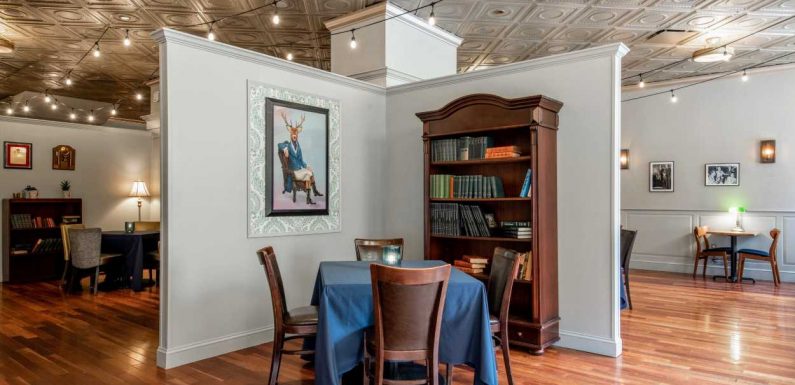
How does a person dine out without encountering hosts, servers or chefs?
Rabbi declares, 'Light will always win over darkness!' a year after anti-Semitic attack
The Record, Bergen County
Newark Police Officer in court on murder charges
The Record, Bergen County
Video: How to make a Turkish cheese roll
The Record, Bergen County
Mahwah joins growing list of NJ municipalities regulating non-native invasive plants
The Record, Bergen County
VIDEO: Fatal head-on collision closes Wayne's Hamburg Turnpike
The Record, Bergen County
COVID-19 vaccinations being given to Bergen County healthcare workers
The Record, Bergen County
Passaic mural focuses on African American history
The Record, Bergen County
Immigrant advocates walk for driver's licenses for undocumented immigrants
The Record, Bergen County
2020 from above: Scenes from our year in drone photojournalism
The Record, Bergen County
One person missing from house fire in Lodi
The Record, Bergen County
American Red Cross helps victims of house fires
The Record, Bergen County
Parishoners still await findings in case of priest who allegedly stole $1 million
The Record, Bergen County
DPW recycling would remain at current locale on North Railroad Avenue
The Record, Bergen County
Shooting scene in Paterson
The Record, Bergen County
Christmas storm results in tree vs house
The Record, Bergen County
Rabbi declares, 'Light will always win over darkness!' a year after anti-Semitic attack
Rabbi declares, 'Light will always win over darkness!' a year after anti-Semitic attack
The Record, Bergen County
Newark Police Officer in court on murder charges
Newark Police Officer in court on murder charges
The Record, Bergen County
Video: How to make a Turkish cheese roll
Video: How to make a Turkish cheese roll
The Record, Bergen County
It’s an impossible question. The hospitality industry is, at its core, hospitable. A friendly smile is shrouded behind a mask. A handshake is impossible from 6 feet apart. Pulling out a chair, handing over a menu, pouring a drink and plating a meal all require the thing we were emphatically told not to do this year: be in close contact with others.
But in 2020, we still tried to dine out. Boy, did we try. (And the hundreds of thousands of people who rely on the restaurant industry for employment thank us for that.)
Start the day smarter. Get all the news you need in your inbox each morning.
Tents, igloos, picnics, plexiglass, indoor nooks and outdoor greenhouses – restaurants tried dozens of creative ways to give diners a semblance of safety.
But were these methods safe enough?
“It’s a spectrum,” said Dr. Henry F. Raymond, associate professor and epidemiologist at the Rutgers School of Public Health. “The best place to dine is at home in your bubble. The next best place is at a picnic with your bubble in a wide-open space.”
So our early months of contactless delivery placed on doorsteps and drive-by pickup orders chucked into open trunks were likely the safest.
Though, Raymond admits, we have precious little data to determine the safest way to dine out. More extensive contact tracing would lead to more precise data on how disease spreads. But, as of now, scientists have little research on how and if COVID-19 cases spread in restaurants, Raymond said.
What we do know, he said, is that COVID-19 spreads mainly through large respiratory droplets that are expelled when people sneeze or cough. The more airflow to move those droplets away, the better.
Food trends: 20 ways restaurants, dining out will change in 2021
‘What’s a heater gonna do when it’s 30 degrees’: Restaurants face bleak winter during COVID-19
And outside, there’s plenty of airflow. In early summer, states began allowing outdoor dining. Entrepreneurial minds got to work.
In New Jersey, municipalities including Hoboken, Ridgewood, Rutherford, Montclair, Hawthorne, Summit and Millburn closed off swaths of streets, opening them up for outdoor dining. Rows of tables shaded by umbrellas were placed on sidewalks and in parklets. Suddenly, downtowns started to look a lot more European.
Other restaurants converted parking lots into dining spaces. Some simply propped up a white tent and threw some durable tables and chairs underneath. Others brought the comforts of indoor dining outdoors.
Elia, a fine Mediterranean restaurant in East Rutherford, New Jersey, filled its billowing white tents with cream-colored couches, dainty chandeliers and terra-cotta pots sprouting banana leaves and palms.
“Our clients that come in love the indoor space, that Greek atmosphere, the feel of being on the island and lounging on the couches,” said owner Anna Rosati. So she re-created that outside.
Acclaimed restaurant Blue Hill at Stone Barns in Pocantico Hills, New York – which specializes in meticulous fine dining and ultra-local ingredients sourced by chef Dan Barber – had its own solution to serving outdoors during a pandemic: picnic baskets. Guests could choose from what was fresh and available at Blue Hill that day to go in their baskets: waxed beans, mahi-mahi tartare, a crusty loaf of bread and more to be eaten on Blue Hill’s patio.
“The baskets were very much following what the restaurant has been doing for years,” said director of operations Philippe Gouze. “Basically, serving what the farmers have for us.”
What wasn’t in the basket – grilled meats, dishes that needed to be served hot or frozen – was served to diners on a wooden pizza peel while the server stood a few feet away. Blue Hill stopped offering picnic baskets only a few weeks ago, when the weather got too cold.
“There’s so much beauty in outdoor dining,” Gouze said. “That was the lesson for us. Whatever happens in the future, we’re not going to be as snooty about how we serve.”
At the end of summer, the igloos came.
These clear domes that sheltered a single group during their meal popped up outside Germantown Garden Grill in Philadelphia. And in New Jersey at Blossom in Palisades Park, Congress Hall in Cape May, Fig and Lily Garden in Morristown, El Tango Argentina Grill in Moonachie and more.
Igloos became a solution for chilly autumn and early winter days. The clear plastic trapped in heat from the sun, and some restaurants installed electric heaters inside the domes as well.
Story continues below the gallery
Asbury Festhalle & Biergarten in Asbury Park, New Jersey, has been installing igloos on its rooftop bar area for five years. Usually, they’re just a way for customers to drink and dine outside during the winter (their bubbles are warmed with electric heaters). This year, they guarded against germs, as well.
“The single-party igloo is a pretty safe option,” Raymond said, “if it’s being cleaned in between and aired out.”
According to Asbury Festhalle & Biergarten general manager Nick Falco, after each reservation, the staff uses an aerosol-based disinfectant on the PVC cover and disinfects with hospital-grade hydrogen peroxide. The igloos are aired out for at least 15 minutes before a new party is seated.
“They’ve always been popular,” Falco said. “Everyone wants those 5 to 8 p.m. reservations on Fridays and Saturdays.”
Restaurants without igloos had to rely on heating lamps and firepits to provide warmth to outdoor diners. Some spots offered blankets to ward off the cold.
“We gave out blankets pre-COVID,” said Andrew Tyler, general manager of The Hill in Closter, New Jersey. “I have about 20 blankets, so during COVID, I only offered them 20 times, one use per blanket. After that, they haven’t been used.”
Instead, handy firepits were the key to comfort at the ritzy restaurant’s outdoor tables.
The year in food: Online delivery changed how we eat in 2020
More: Barstool Sports founder donates money to help New Jersey restaurant
Paul Vagianos, owner of It’s Greek to Me in Ridgewood, New Jersey, put his own spin on outdoor dining by constructing “greenhouses” warmed with electric wall heaters and decorated with string lights and wreaths.
“We have to stay ahead of the curve. The regular business model doesn’t work,” Vagianos said.
Between groups, the greenhouses are disinfected and aired out with a sanitary air blower. The 6-foot-by-6-foot structures stay nice and toasty, fit perfectly on the sidewalk and have room for a four-person table.
“I want everyone in Ridgewood to use these,” he said. “We could have a Christmas village all winter long. Without innovation, all you’ve got is takeout.”
As states began allowing indoor dining, that innovation moved indoors. Arrows were taped on floors to direct the flow of traffic. Plexiglass barriers were installed between tables. Air filtration systems were purchased. Windows were left open to increase airflow. Tables were spaced 6 feet apart and dining capacity was reduced.
In Philadelphia, Jose Garces’ The Olde Bar constructed nooks inside its library-themed room. Fourteen dining nooks shielded by two solid walls were built in the seafood restaurant, known for its iconic snapper soup. QR codes were placed inside books at each table in lieu of menus. Vintage lamps, rows of classic books and quirky works of art jazzed up the redesigned space. (The city has since shut down all indoor dining through January.)
There are likely still stones left unturned – ways to revolutionize restaurant dining to make it as contact-free as possible while retaining some semblance of hospitality. But with every evolution of dining we saw in 2020, truly contactless dining is still impossible. As is supporting local businesses without introducing risk into your life. As is keeping a restaurant open with a fraction of the customers and staff. As is supporting one of the country’s largest industries without adequate assistance.
As we enter a new, hopefully, kinder, year, Raymond compares the restaurant industries’ efforts in 2020 to airport security.
“Does taking off our shoes at the airport really help us? So much of what TSA does is theater based on some educated guesses,” he said. “The situation with restaurants is similar. We can do the best we can do – but it’s hard to figure out how much is keeping us safe and how much is just making us feel better.”
Rebecca King is a food writer for NorthJersey.com.
This article originally appeared on NorthJersey.com: Igloos, nooks and greenhouses: A review of the many ways we dined in 2020
Source: Read Full Article




































